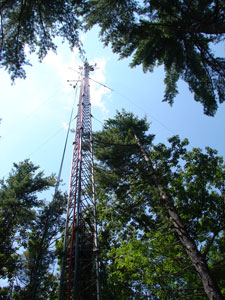Can Photosynthesis be Measured Over Large Areas? MBL, Brown University Scientists Find a Way

Contact: Diana Kenney, Marine Biological Laboratory
dkenney@mbl.edu; 508-389-7139
WOODS HOLE, Mass., and PROVIDENCE, R.I.—By mounting cameras and spectral sensors over a forest canopy in central Massachusetts, scientists have developed an innovative system to measure plant photosynthesis over large areas, such as acres of crops or trees, using information on solar-induced fluorescence in the leaves. The system, which can monitor plant growth and several other ecosystem changes, was developed by a team led by Marine Biological Laboratory (MBL) and Brown University scientists. It is described in a recent paper in Geophysical Research Letters.
 Cameras and sensors installed on a tower in a Massachusetts forest continuously collect environmental data, including on photosynthetically active radiation. Credit: Jim Tang
Cameras and sensors installed on a tower in a Massachusetts forest continuously collect environmental data, including on photosynthetically active radiation. Credit: Jim Tang“Plant photosynthesis is a fundamental process that drives all ecosystem functions. Despite established knowledge on how to measure and model photosynthesis on the leaf scale, measuring photosynthesis on the canopy scale has been challenging,” says Jim Tang, associate scientist in the MBL Ecosystems Center. By analyzing the spectral signals captured by a special sensor they installed at Harvard Forest in Petersham, Mass., “We found fluorescence data well correlated with photosynthesis that was measured by another independent method. This is the first time that satellite-based fluorescence is validated by ground measurements,” Tang says.
“This work has profound applications, as we can easily install this system into a drone, airplane, or satellite to detect plant photosynthesis on a large scale to assess ecosystem health,” says lead author Xi Yang, a postdoctoral associate at Brown University. “We may also apply this to agriculture for predicting crop yield, drought condition, or insect outbreak.”
Chlorophyll fluorescence is a byproduct of photosynthesis: under the sunlight, a small portion of solar energy (< 1 percent) captured by chlorophyll is emitted as fluorescence. However, recording the signal from that fluorescence is extremely difficult because it is obscured by the much higher intensity of solar radiation. The group discovered a few wavelengths of light that allow measuring the specific fluorescence signal from photosynthesis. The team’s fluorescence measurement system can record radiation at high resolution with a frequency of 5 minutes, thus automating detection of photosynthesis from the canopy.
Yang is a recent graduate of the Brown-MBL Graduate Program in Biological and Environmental Sciences. He began this research with his Ph.D. advisors, Tang at MBL and John F. Mustard, professor of Earth, Environmental and Planetary Sciences at Brown University. Other contributors to the study include Jung-Eun Lee of Brown University, Micol Rossini of Universit`a degli Studi Milano-Bicocca, Joanna Joiner of NASA Goddard Space Flight Center, J.William Munger of Harvard University, Ari Kornfeld of Stanford University, and Andrew D. Richardson of Harvard University.
Citation:
Yang, X., J. Tang, J. F. Mustard, J.-E. Lee, M. Rossini, J. Joiner, J. W. Munger, A. Kornfeld and A. D. Richardson (2015). Solar-induced chlorophyll fluorescence that correlates with canopy photosynthesis on diurnal and seasonal scales in a temperate deciduous forest. Geophys. Res. Lett. 42, DOI:10.1002/2015GL063201.
—###—
The Marine Biological Laboratory (MBL) is dedicated to scientific discovery and improving the human condition through research and education in biology, biomedicine, and environmental science. Founded in Woods Hole, Massachusetts, in 1888, the MBL is a private, nonprofit institution and an affiliate of the University of Chicago.